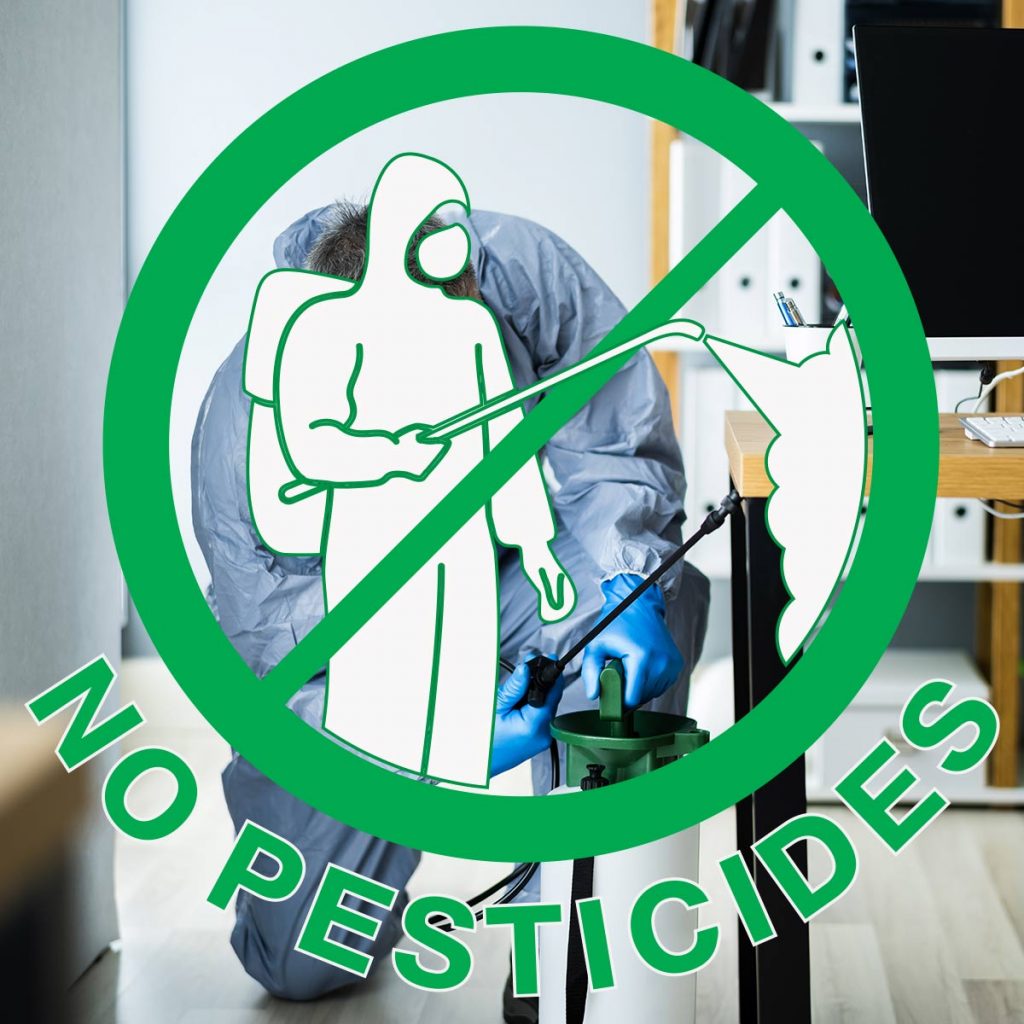Although you may have heard people use the terms “green pest control” and “green pesticides” interchangeably, they don’t mean the same thing. The term green pesticide generally refers to organic pesticides—non-synthetic chemicals designed for use on food crops. But the term green pest control refers to a system of Integrated Pest Management (IPM) practices that may include the use of synthetic pesticides.
Green pest control prioritizes human and environmental safety, but it also recognizes that some pest problems can only be mitigated with the use of synthetic chemicals. So, if you came to this article wondering whether green pest control is effective, the answer is yes. But if you were wondering whether green pesticides are effective for use on your home or property—well, let’s clear up this confusion the rest of the way and find out, “are green pesticides effective? or are they not?”

Green Pest Control Vs. Green Pesticide
Make no mistake: a pesticide is any chemical that can kill or repel a living organism, so by definition, there’s no such thing as a completely safe one, not even among organic chemicals. This is why the EPA doesn’t allow the use of safety claims on organic products; they’re all harmful in one way or another.
With that said, the USDA does have guidelines in place for the use of organic (or green) pesticides in agricultural applications. These products are not allowed to contain genetically modified organisms or man-made chemicals.
But the USDA standards are only applicable to food production, so the concept of green pesticides has no relevance to property owners hoping to keep the bugs and rats out. This is the province of green pest control professionals, so unless you’re planning to grow organic rutabagas in your house, this is the correct terminology.

How Does Green Pest Control Work?
Although green pest control methods may include the use of synthetic pesticides, this is a small part of Integrated Pest Management, and it only occurs at the end of a comprehensive evaluation process. Here’s the full outline of an IPM/green pest control plan:
- Inspection and monitoring of structures and surrounding ecosystems – Green pest control always begin with a thorough evaluation of pest habitats, populations, traffic patterns, and incursion risks on your property. A typical IPM plan includes regular, 90-day follow-up inspections to continue monitoring populations.
- Pest exclusion/pest proofing/sanitation – Many pest problems are caused or exacerbated by poorly sealed food stores; structural cracks, leaks and other pest entry points; or other factors that encourage infestation in or around structures. An IPM plan may include making repairs or taking other steps to discourage or trap pests before they enter areas of human habitation.
- Customer communication and documentation – This is hugely important to the success of an IPM plan because “green pest control” only works with an informed property owner. Good documentation also allows technicians to monitor changes in pest behaviors and track the effectiveness of mitigation measures over time.
- Application of low-risk pesticides – By the time an IPM plan reaches this step, the amount of pesticide needed is often small. Because these methods focus on highly targeted management of specific pest populations over time, pesticide use may be reduced by as much as 90 percent, compared to the “scorched-earth” approach of old-school methods. When chemical treatments are applied, it’s usually done with specialized equipment that targets specific pest populations in areas of known vulnerability, away from human exposure.

What are Some Examples of Green Pest Control?
The biggest weapon in the IPM arsenal is knowledge. Pests are attracted to human structures for specific reasons, and an understanding of pest biologies and behaviors is worth many barrels of bug spray. Sanitation and preventative measures solve a lot of problems before they occur, but even after an infestation, there are plenty of green strategies that make quick work of pests without spraying chemicals into the air. Well-placed baits may be used to target the nests and queens of ant populations that live outside a structure while stealing food from inside it. Boric acid powder can be applied to roach traffic areas with no risk at all to humans, but it’s quite deadly to the target species.
Any pest problem can be solved with enough poison. But when we understand pest habitats, traffic patterns, and behaviors, relatively tiny amounts of poisons can be hugely effective—if they’re necessary at all.

Thanks for reading Go Green Pest Control’s blog, “Are Green Pesticides Effective?”. If you live in Wichita, Manhattan, or Junction City, Go Green can help. Give us a call at (316) 733-0687 in Wichita or (785) 377-0687 in Manhattan and Junction City. Just ask us how green effective green pesticides can be for you?







